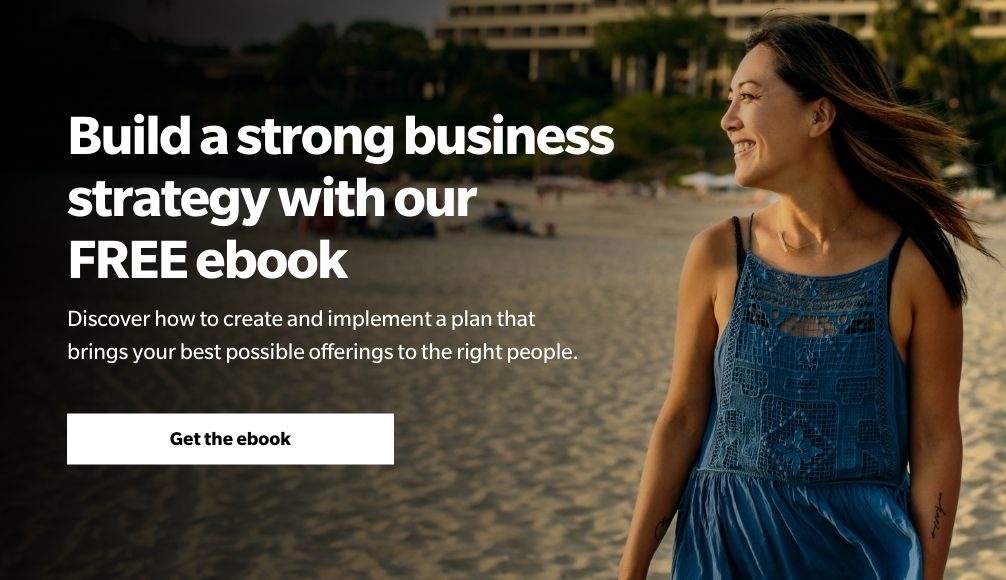If there’s one thing any entrepreneur should keep in mind while developing a strong product strategy, it’s this: Where’s the gap in your market, and how can you fill it? The product or service that your small business offers is undeniably unique—you wouldn't have begun your own business otherwise. But trying to tangibly identify exactly how your product can satisfy customers’ needs—unlike anything else out there—can be a challenge. How can you take a step back from something you’re so intimately involved in, day in and day out, to see it as something new, from your target customer’s perspective?
This step-by-step approach will help you create a masterful product strategy that tailors your offerings to fill a sweet spot in the market as only your business can, all while considering the wants and needs of your ideal prospect?
1. Clearly identify your target audience
Who is your ideal customer, and what do they need and want? Before you can better understand what your target market is looking for in a product or service, you first need to answer these questions.
Finding your ideal customer is the foundational base of your general product strategy—since not everyone is your ideal customer, your product doesn’t suit everyone. Why waste valuable resources on trying to market to people who simply aren’t looking for what you’re offering?
Start by deciding which factors are most critical to your customer persona and do some research, compiling demographic and psychographic information to create a prospect profile.
Demographics answer the question, “Who are they?”. This includes age, employment status, location, gender, education level, race, occupation, marital status, income, family size, and so on. These tangible factors compose an individual’s identity. Psychographics then go on to ask, “How do they think?”. Consider their personal image, their values, their external perceptions and world views, and what motivates them to make a purchase.
By collecting this info through customer surveys, interviews, focus groups and observations, as well as some online resources, you’ll be able to craft a profile that reveals your ideal customer’s needs and desires.
2. Profile the ideal product for your market
Even if you’re in a hyper-specific industry of niche products, you’ll likely need to make a concerted effort to stand out from your competition, especially in an oversaturated market. That’s why creating an ideal profile for your product or service is essential. In doing this, you’re answering questions from the customer’s perspective rather than your own.
As you profile a product that not only appeals to your prospect’s wants and needs, but also helps you to stand out in the market, consider these attributes:
- Functionality
- Sensory impact/design elements
- Unconscious associations (What does your product remind customers of based on their daily habits?)
- Conscious-mind conclusions (What are their motivating factors and purchase habits?)
- Price-value
- Access and convenience
By focusing on specific attributes, you can better determine which ones can give you the upper hand.
Let yourself really get creative here—don’t be afraid to think outside the bounds of practicality. Think of what would truly attract and delight your ideal customer, and keep them coming back for more.
3. Weigh your current product against competing products
With your ideal customer and product profiles in mind, shift gears and look to your competitors who sell similar products or services.
How are their offerings similar to yours, and how are they different?
In what ways are they addressing their audience?
What’s their approach lacking?
By comparing other products in the market, and questioning how they might better address some of your customers’ needs, you’ll see opportunities for improving or innovating your own.
4. Assess the feasibility of your ideal product
Now it’s time to question what’s actually manageable in the present. Can you develop the best possible product or service given your business’ current resources and capabilities?
Maybe you do have the means to execute on your ideal product profile. But more than likely, you may be hard pressed to completely close the gap between your current and target offerings. That’s okay—having a business is all about continuously iterating and growing. If this is the case for you, figure out what feasible adjustments you can make today—and base these on your key attributes. Of all the attributes that you identified as being priorities for your customers, which rise to the top? Are there other businesses out there whose offerings embody those attributes better than yours do? Hone in on those, then create a realistic plan for adapting your product or service to both help you stand out and get closer to the offering you’re ultimately aiming for.
5. Write a powerful USP
It’s not uncommon for small business owners to mistake a USP for a slogan while developing their marketing and product strategies. A USP, or a Unique Selling Proposition, is so much more: it’s a succinct phrase that distinctly communicates the ethos—the compelling emotional promise that only your company can provide. And the shorter, the better. Almost a thought rather than a sentence, your USP is a poignant phrase that can tap into the imagination of the reader. It should align with the customer’s own self perceptions and motivations, and embody the most positive benefits that your product or service offers. What would they be excited to hear? What would delight them?
Developing a strong product strategy is always time well spent—not only will you walk away with a better understanding of your customers and competitors, you’ll also have a new and improved perception of your business and what it offers. You’ll begin to recognize and have more confidence in your unique offerings, find your spot in the market, and connect with your ideal customers.
If you need support to work through your own product strategy, we’d love to connect.




Comments